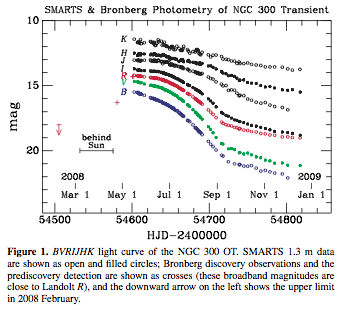Triggers:Other
NGC300-OT
Luminous optical transient was detected in May 2008 in NGC300 by an amateur astronomer B.Monard from South Africa. This object lies in the gap in absolute magnitude between luminous novae and faint supernovae. Nature of the outburst is still debated.
Discovery paper by Bond et al. (2008).
Spitzer/IRS mid-IR spectrum taken 93 days after the maximum (Prieto et al. 2009)
VLT spectropolarimetric follow-up Patat et al. 2009.
- maximum absolute brightness: <math>M_V \simeq -12 to -13</math>
- detected at brightness <math>V\approx14.5 \textrm{mag}</math>
- decay to 20 mag in about 100 days
- intermediate between CN and SN
- suspected to be a twin with SN 2008S (progenitor: luminous star embedded in circumstellar dust)
- probably an explosion of massive (6-10 Msun) carbon-rich AGB/super-AGB or post-AGB star
- no radio or X-ray counterpart detected
- no star visible at that location prior to the outburst on HST archival images.
Sakurai's Object
V4334 Sgr and similar FG Sge...
 Figure from Spano et al. 2009.
Figure from Spano et al. 2009.
Luminous Red Novae
New type of novae, introduced in 2007 with detection of M85OT2006-1 transient Rau et al. 2006. Class contains also M31 RV, V4322 Sgr and V838 Mon.
See also Kulkarni et al.2009.
OT060420
Very short (~12 min) and bright (~ 5 mag) transient detected by CONCAM all-sky cameras [1]. The astronomical nature of the event is disputable, as the detection was made only on two out of three telescopes. One explanation is that the transient was variable.
Gaia will be able to detect such transients and also provide per-ccd photometry, every 4 seconds.
Optical transients due to unbound tidal debris
Quasar flares (?)
Red giants swallowing planets?
Example OGLE-LPV-00861, see Soszynski et al. 2011 and Retter (2006).
